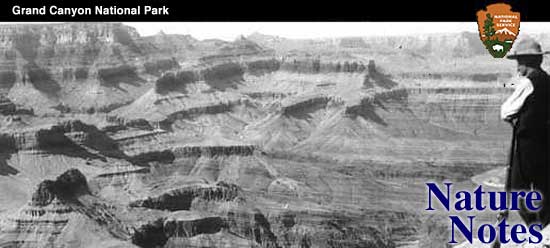

|
By Barbara H. McKee, Grand Canyon. WHERE man upsets the balance of Nature, unforseen consequences are apt to occur. Perhaps you can call to mind the classical examples of the rabbits in Australia and the rat and mongoose in Jamaica. Here at the Grand Canyon likewise, we have found that wild life is very delicately balanced. When, a few years ago a concerted hunt for mountain lions or cougars on the North Rim diminished their numbers very radically, deer increased to such an extent that they literally "ate themselves out of house and home". With few of their hereditary enemies to prey upon them, they multiplied to such numbers that before long, in certain areas, they had practically eaten up all the available food, or browsed it so closely that the plants were in danger of dying. Artificial methods of getting rid of surplus deer have been tried, but none of man's plans have so far proven as efficient as Nature's. The common little chipmunk (Eutamias dorsalis) which is so abundant on the South Rim of Grand Canyon, has found ideal living conditions at Grand Canyon Village. Here, under the eaves and in the unused lofts of many of the Park Service houses, he has moved in and proceeded to raise numerous families of several young. Food has been plentifully supplied by the inhabitants of the house on well filled bird-feeding trays, and so he has found an easy existence practically without the necessity and danger of venturing into the open, where he might himself become a meal for some hawk or other enemy. A few months ago when a bird banding station was started on our feeding trays, we were quite chagrined to find that we caught nothing but chipmunks. When they were turned loose, with check pouches well filled with cracked corn and pinyon nuts, it would not be long until they were back again inside the cage. We saw that something must be done if we were over to band birds. And so it happened that our colony of "chippies" has been moved about a mile east. One at a time as they were caught, we took them out the road and turned them loose. Quite inadvertently we had found an easy method of controlling their numbers in any particular locality.
I might mention that we tried marking the animals before letting them go, in order to discover whether they possessed any homing instinct that would cause them to return to our feeding tray. Without leg bands or clipped ears or tails, however, this seemed impossible, for our doses of water-proof ink made no impression on their waterproof fur. This is just one more example showing how man often inadvertently upsets Nature's balance. Easy living conditions, free of all normal danger, caused the chipmunks to increase at Grand Canyon Village to large numbers. With our bird-banding cage we have tried a method of live trapping which has proven highly successful in remedying an undesirable situation, and illustrates a method of handling animals, which may be applied to many other species.
| ||||||
| <<< Previous | > Cover < | Next >>> |
vol8-4d.htm
14-Oct-2011